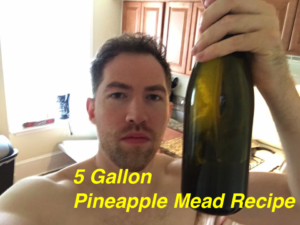Recently I had the pleasure of making 5 gallons of pineapple mead with my friend Duke. This batch of mead came out really good.
The process by which we made this batch was slightly different from how we usually go about it. Usually we just throw everything in the primary fermenter, but this time we decided to try and stop fermentation and put fruit in the secondary to get more fruit flavor.
We’ve never done this process before and although it adds an extra step, it’s completely worth it because you will have a much more pronounced fruit taste in your mead.
The added step is called stabilization and essentially stops fermentation. The reason you want to stop fermentation is because once you introduce more sugar into the mix, the yeast will just start fermentation up again and eat all the juice. You don’t want this to happen.
How we decided on a pineapple mead
Here’s a funny thing about making mead, how you decide what mead to make is usually just finding out what you have around the house. Case in point, when Duke and I decided to make 10 gallons of mead, we saw that he had a bunch of pineapple sitting in his house. This sparked the idea to use it for our mead.
What would pineapple mead taste like? We had no idea, but we thought for sure it would taste exceptional.
“Hey Tate, I think we should make 10 gallons of mead, 5 of which is citrus, 5 of which is pineapple, thoughts?”
“Done.”
Ingredients
- Home Brewing Kit
- 15 lbs Clover Honey
- 5 gallons of distilled water
- 1 packet of Lavlin 71 B 1122 yeast
- 2 Pineapples
- Potassium Metabisulfate
- Potassium Sorbate
Process
- Sanitize your fermentation bucket and all the tools you will be using. Get out 2 gallons of your distilled water and pour it into the bucket.
- Put your honey in some warm water to help liquify it to make it easier to pour. Once liquified, pour your honey into your bucket.
- Stir the honey until it’s completely mixed with the water. Pour in the other gallon jugs of water that you have until it’s up to 5 gallons.
- Keep stirring for 10 minutes to aerate the must.
- Take an initial reading with your hydrometer here.
- Measure out a tsp of Goferm and Fermaid-K and divide it into 4 parts. Save this mix to add to your mead on a staggered schedule.
- Take some warm water and mix it with your packet of 71B 1122 yeast in a sanitized container.
- After a few minutes of rehydrating the yeast, throw the yeast into your honey water mixture in the bucket. Then throw in 1/4 of your Goferm/Fermaid-K mix as well. Stir lightly for a second or two.
- Put the lid on your bucket and attach an airlock.
- For 5 days after this, lift the lid off and stir lightly for a few minutes. This will degas the co2 and introduce oxygen into the mix. This speeds up fermentation.
- Add your 2nd part of your Goferm/Fermaid-K mix 48 hours after pitching your yeast. Add your 3rd part 4 days later. Add your 4th and final part 8 days later.
- After about a month later take a reading to see where you are at in the fermentation. If you have fermented most of your honey at this point, it’s time to stabilize. It should be somewhere around 14-15 %.
- Take 5/16 tsp of potassium metabisulfite and place it in your mix. Stir it in very lightly so as to not cause bubbling. After 2 hours, take 2 1/2 tsp of potassium sorbate and pour it in your mix. Stir this in lightly to avoid bubbling. Let this mix sit for 48 hours.
- During the 48 hour wait, take your two pineapples and cut them up. Place it into a ziplock bag and put the bag into your freezer. This will help break down the cell walls of the pineapples which helps to impart more flavor into your mead.
- After the 48 hours, take your pineapples out of the ziplock bag and put them in a sanitized carboy.
- Take the lid off of your fermentation bucket and siphon your mead on top of the pineapples in the carboy. Attach an airlock to the carboy and let it sit for 2 months.
- Siphon into your bottling bucket, take a final reading with your hydrometer, and bottle your mead.
- Enjoy!
This will yield 2 cases of 750 ml bottles of mead. The pineapple flavor is very light and fruity and mixes well with the alcohol taste. It’s my best mead to date that I have made.
Start home brewing today with your own kit!
-Tate

